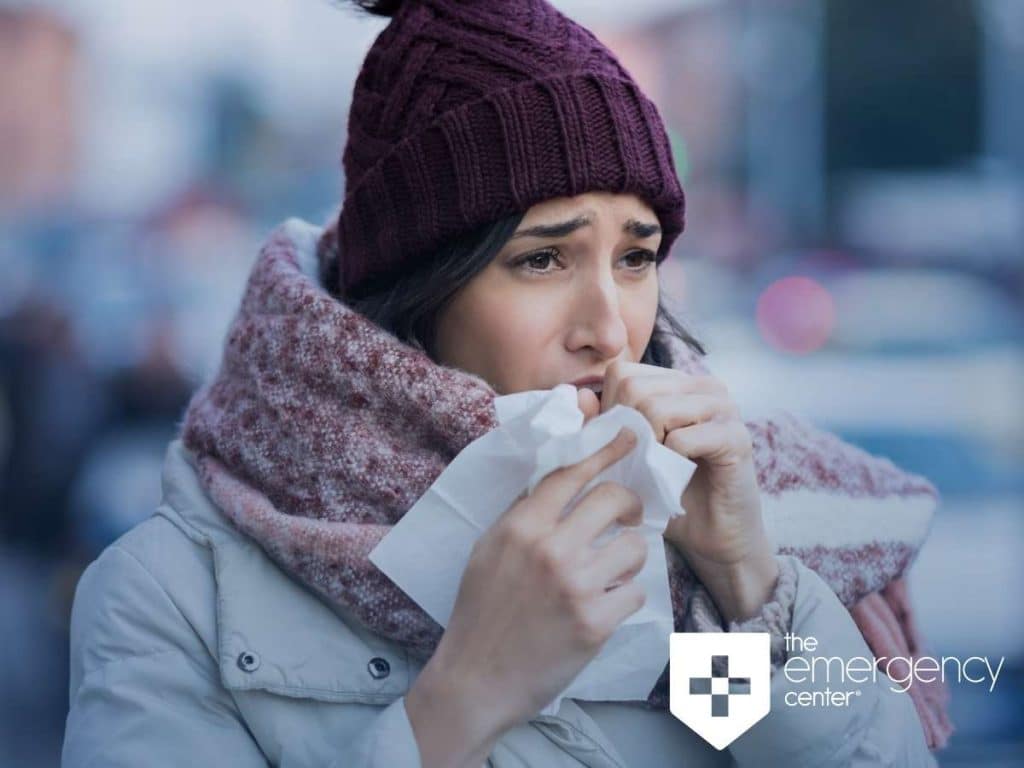Fall & Winter Illnesses
9 Common Winter & Fall Illnesses & Their Symptoms
Summer has come and gone, and people are preparing for winter and fall – and the illnesses that come with them. Many illnesses thrive in the fall and winter, and it is essential to spread awareness of these ailments to educate people and prevent them from becoming sick. Asthma, flu, heart conditions, and related illnesses cause many emergency room visits during this time of year than any other.

Common Illnesses In The Winter & Fall
Deaths occur more in winter than in spring or summer, according to the Center for Disease Control and Prevention (CDC). Those with asthma or a preexisting heart condition are also more likely to be hospitalized during the colder seasons. Several illnesses thrive during this time of year, many of which can be severe.
-
Strep Throat
Streptococcal pharyngitis is more commonly known as strep throat. It is a bacterial infection in the back of the neck and the tonsils. It is highly contagious and is common during the fall and winter seasons. One distinctive sign of strep throat is redness and swelling of the tonsils. There will also be noticeable white patches inside the throat. Symptoms include an intense soreness in the throat, a runny nose, and fever in some cases.
-
Asthma
Asthma is a condition in which the airways located in the lungs become narrowed and fill with mucus. The condition can be genetic, but it also thrives on environmental factors such as fall and winter temperatures. The symptoms cause breathing difficulties, wheezing, and tightness in the chest. Although there is no known cure for asthma, medication can help minimize the symptoms.
-
Pneumonia
Pneumonia is an inflammation of the lungs. There are small air sacs in the lungs, called alveoli, which are primarily affected by pneumonia. The inflammation causes shortness of breath, fever, chest pain, and dry coughing. The severity of pneumonia can range from mild to fatal.
-
Bronchitis
Inflammation of the bronchial tubes is known as bronchitis. It can be acute or chronic. Bronchitis can evolve from a cold or can develop from another respiratory infection. Just as it is with most fall and winter health problems, the inflammation causes tightening in the chest, coughing, wheezing, and chest pains. In some cases, it can even create a slight fever.
-
Bronchiolitis
Children less than two years of age are most likely to develop bronchiolitis. The condition is typically a viral infection of small airways located in the lungs. It causes a runny nose, fever, cough, and breathing difficulty. Bronchiolitis is most common during the winter months.
-
Hypothermia
Once the internal body temperature lowers from the average 98.6 degrees Fahrenheit to below 95 degrees, symptoms of hypothermia start to show. These symptoms include dizziness, shivering, weak pulse, memory loss, and can be fatal if not addressed immediately. The condition results form by prolonged exposure to lower temperatures, such as in the fall and winter seasons.
-
Pertussis
Pertussis is a bacterial disease that is commonly known as whooping cough. It is a highly contagious respiratory disease than can spread rapidly. It is widely known to cause breathing difficulties due to uncontrollable coughing fits. The symptoms initially start like those of the common cold, but the coughing fits intensify and can last for up to ten weeks. The disease is prevalent in children and infants. Fortunately, some vaccines can prevent whooping cough, so parents must keep their children’s vaccines up to date.
-
Conjunctivitis
Also known as pink eye, winter is peak season for conjunctivitis. It a contagious eye infection commonly found in children. Conjunctiva is the outer most layer of the eye. During the winter season, it can become inflamed from direct contact to specific viral or bacterial contagions. The infection causes the conjunctiva to become swollen, and the result is a notable reddening of the eye and discharge. Pink eye is most contagious when a discharge is present. Darker colored discharge typically indicates a bacterial infection. While viral pink eye infections go away on their own over time, antibiotics can treat bacterial conjunctivitis.
-
Norovirus
Norovirus can often be the cause of gastroenteritis. Because it is most common during the winter season, it is also known as the winter vomiting bug. The virus triggers sudden vomiting and diarrhea in patients. The condition is highly contagious, and people contract it through food, water, or other surfaces contaminated with the virus. It isn’t pleasant, but it typically lasts only for a few days.
How To Keep From Getting Sick This Fall & Winter
Most of these maladies can happen at any time of year. During the fall and winter seasons, however, they are much more prevalent. During the colder times of the year, be sure to bundle up, stay warm, and take all other helpful steps to minimize the chances of falling ill. These steps include hand washing, getting vaccinated for the flu and pneumonia if advised, and using hand sanitizer when traveling, especially in airports and on airplanes.
The Emergency Center is here for you if you get sick this fall and winter! The Emergency Center provides up to 23 hours of Observation and offers 24/7 care with NO WAITING. Visit The Emergency Center’s convenient 24-hour location.

The Emergency Center
San Antonio
11320 Alamo Ranch Pkwy
San Antonio, TX 78253
Phone: 210-485-3644
Conroe
4019 I-45 N,
Conroe, Texas 77304
Phone: 936-247-9457
